
The Distinguished Conduct Medal was a decoration established in 1854 by Queen Victoria for gallantry in the field by other ranks of the British Army. It is the oldest British award for gallantry and was a second level military decoration, ranking below the Victoria Cross, until it was discontinued in 1993 when it was replaced by the Conspicuous Gallantry Cross. The medal was also awarded to non-commissioned military personnel of other Commonwealth Dominions and Colonies.
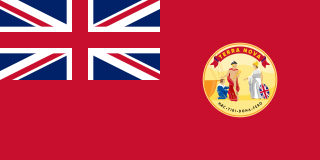
Newfoundland was a British dominion in eastern North America, today the modern Canadian province of Newfoundland and Labrador. It was confirmed by the Balfour Declaration of 1926 and the Statute of Westminster of 1931. It included the island of Newfoundland, and Labrador on the continental mainland. Newfoundland was one of the original dominions within the meaning of the Balfour Declaration, and accordingly enjoyed a constitutional status equivalent to the other dominions of the time.

The Royal Newfoundland Regiment is a Primary Reserve infantry regiment of the Canadian Army. It is part of the 5th Canadian Division's 37 Canadian Brigade Group.

The Africa Service Medal is a South African campaign medal for service during the Second World War, awarded to members of the Union Defence Forces, the South African Police and the South African Railways Police. The medal was originally intended for service in Africa, but it was later extended to cover service anywhere in the world.
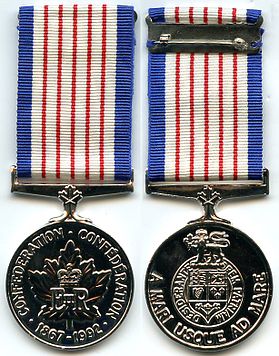
The 125th Anniversary of the Confederation of Canada Medal is a commemorative medal struck by the Royal Canadian Mint to commemorate the 125th anniversary of the Confederation of Canada and was awarded to Canadians who were deemed to have made a significant contribution to their fellow citizens, to their community, or to Canada. Nominations were submitted to lieutenant governors and territorial commissioners, senators, members of parliament, provincial governments, the Public Service Commission of Canada, the Canadian Forces, the Royal Canadian Mounted Police, and various federal government departments, as well as organizations throughout the country, and some 42,000 medals were awarded.
The Canadian Centennial Medal is a commemorative medal struck by the Royal Canadian Mint in 1967 to commemorate the 100th anniversary of the Canadian Confederation and was awarded to Canadians who were recommended by government, professional, educational and cultural associations, as well as military and protective services, veterans' groups, sports associations, and philanthropic and charitable bodies, for having provided valuable service to Canada. Some 29,500 medals were issued after its inauguration on 1 July 1967, of which 8,500 went to personnel in the Canadian Forces.

The history of Canada during World War II begins with the German invasion of Poland on 1 September 1939. While the Canadian Armed Forces were eventually active in nearly every theatre of war, most combat was centred in Italy, Northwestern Europe, and the North Atlantic. In all, some 1.1 million Canadians served in the Canadian Army, Royal Canadian Navy, Royal Canadian Air Force, out of a population that as of the 1941 Census had 11,506,655 people, and in forces across the empire, with approximately 42,000 killed and another 55,000 wounded. During the war, Canada was subject to direct attack in the Battle of the St. Lawrence, and in the shelling of a lighthouse at Estevan Point on Vancouver Island, British Columbia.
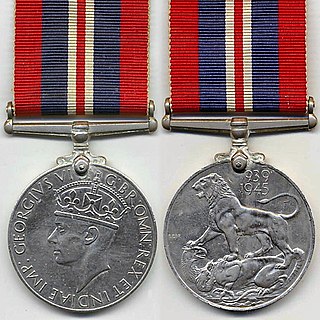
The War Medal 1939–1945 is a campaign medal which was instituted by the United Kingdom on 16 August 1945, for award to citizens of the British Commonwealth who had served full-time in the Armed Forces or the Merchant Navy for at least 28 days between 3 September 1939 and 2 September 1945.
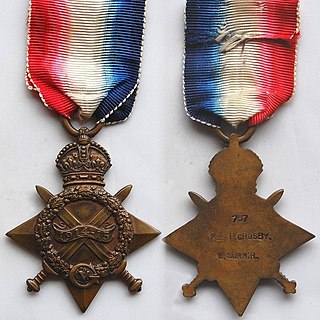
The 1914–15 Star is a campaign medal of the British Empire which was awarded to officers and men of British and Imperial forces who served in any theatre of the First World War against the Central European Powers during 1914 and 1915. The medal was never awarded singly and recipients also received the British War Medal and Victory Medal.

The British War Medal is a campaign medal of the United Kingdom which was awarded to officers and men and women of British and Imperial forces for service in the First World War. Two versions of the medal were produced. About 6.5 million were struck in silver and 110,000 in bronze, the latter awarded to, among others, the Chinese, Maltese and Indian Labour Corps.

The Defence Medal is a campaign medal instituted by the United Kingdom in May 1945, to be awarded to citizens of the British Commonwealth for both non-operational military and certain types of civilian war service during the Second World War.
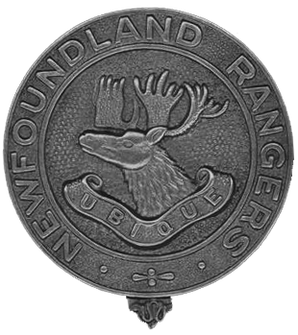
The Newfoundland Ranger Force was the police force of the Dominion of Newfoundland. It provided law enforcement and other government services to outports for 15 years. It existed from 1935 to 1949, at which point it was merged into the Royal Canadian Mounted Police (RCMP). 204 men served as Rangers during its existence, though at any given time the force did not exceed 72 members.
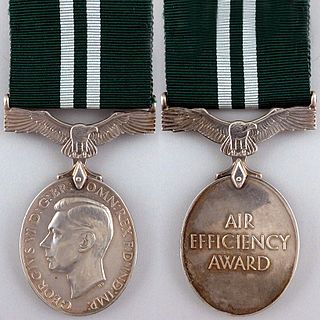
The Air Efficiency Award, post-nominal letters AE for officers, was instituted in 1942. It could be awarded after ten years of meritorious service to officers, airmen and airwomen in the Auxiliary and Volunteer Air Forces of the United Kingdom and the Territorial Air Forces and Air Force Reserves of the Dominions, the Indian Empire, Burma, the Colonies and Protectorates.

The Canadian Volunteer Service Medal is granted to persons of any rank in the Naval, Military or Air Forces of Canada who voluntarily served on Active Service from September 3, 1939, to March 1, 1947. The medal was established on October 22, 1943.
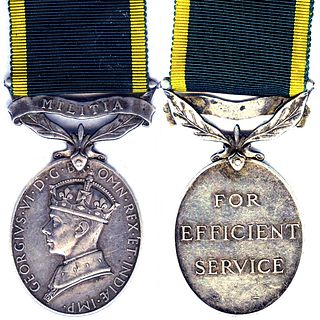
The Efficiency Medal was instituted in 1930 for award to part-time warrant officers, non-commissioned officers and men after twelve years of efficient service on the active list of the Militia or the Territorial Army of the United Kingdom, or of the other Auxiliary Military Forces throughout the British Empire. At the same time a clasp was instituted for award to holders of the medal upon completion of further periods of six years of efficient service.
The Canadian Volunteer Service Medal for Korea was a campaign medal created in 1991 by the Canadian monarch-in-Council to recognize former members of the Canadian Army, Royal Canadian Navy, and Royal Canadian Air Force who had volunteered to participate in the Korean War, either on the Korean Peninsula itself or in surrounding areas. It is, within the Canadian system of honours, the second highest of the war and operational service medals.
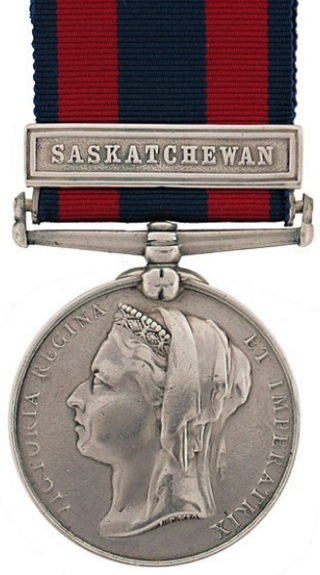
The North West Canada Medal is a British campaign medal issued to the soldiers, volunteers, and North-West Mounted Police (NWMP) personnel who participated in putting down the North-West Rebellion in 1885.

The Arctic Star is a military campaign medal instituted by the United Kingdom on 19 December 2012 for award to British Commonwealth forces who served on the Arctic Convoys north of the Arctic Circle, during the Second World War.

The Colonial Auxiliary Forces Officers' Decoration, post-nominal letters VD, was established in 1899 as recognition for long and meritorious service as a part-time commissioned officer in any of the organized military forces of the British Colonies, Dependencies and Protectorates. It superseded the Volunteer Officers' Decoration for India and the Colonies in all these territories, but not in the Indian Empire.

In 1895, Queen Victoria authorised Colonial governments to adopt various British military decorations and medals and to award them to their local military forces. The Colony of Natal introduced this system in August 1895 and, in 1897, instituted the Distinguished Conduct Medal (Natal), post-nominal letters DCM.



















